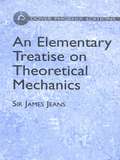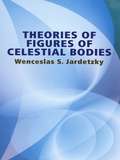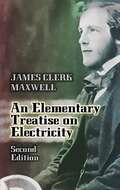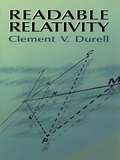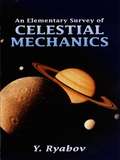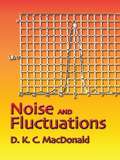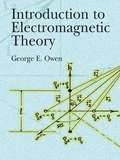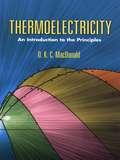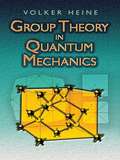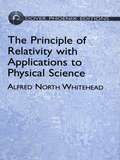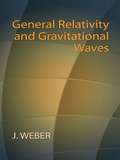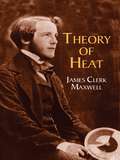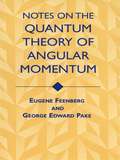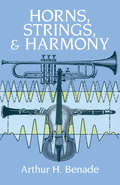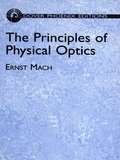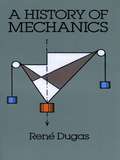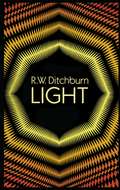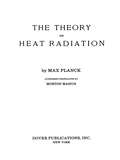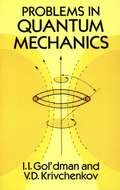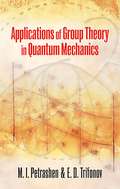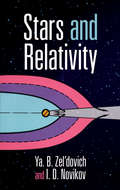- Table View
- List View
An Elementary Treatise on Theoretical Mechanics (Dover Books on Physics)
by Sir James JeansIn addition to being among the twentieth century's major scientific figures, Sir James Jeans (1877-1946) was also one of the greatest modern science expositors. His classic introduction to mechanics endures as a clear and concise presentation of first principles.Although brief, it encompasses a remarkably wide selection of topics. Its subjects include rest and motion, force and the laws of motion, forces acting on a single particle, statics of systems of particles, statics of rigid bodies, center of gravity, work, motion of a particle under constant forces, motion of systems of particles, motion of a particle under a variable force, motion of rigid bodies, and generalized coordinates. Within each chapter, the author carefully explains the most elementary concepts (such as velocity, acceleration, Newton's laws, friction, moments, and kinetic energy), and he illustrates them with examples.Ideal for beginning physics students or for more advanced readers in need of refreshment, the text emphasizes the fundamental physical principles rather than mathematics or applications. So clearly written that it can be read and understood outside the classroom, it features hundreds of fully worked illustrative examples and test exercises.
Theories of Figures of Celestial Bodies
by Wenceslas S. JardetzkySuitable for upper-level undergraduates and graduate students, this text explores the most exact methods used in the theory of figures of equilibrium. It also examines problems concerning the figures of celestial bodies, including invariable or varying figures, zonal rotation, systems composed of fluid and rigid parts, and more. 1958 edition.
An Elementary Treatise on Electricity: Second Edition (Dover Books on Physics)
by James Clerk MaxwellAlbert Einstein characterized the work of James Clerk Maxwell as the "most profound and the most fruitful that physics has experienced since the time of Newton." Max Planck went even further, declaring that "he achieved greatness unequalled," and Richard Feynman asserted that "From a long view of the history of mankind -- seen from, say, ten thousand years from now -- there can be little doubt that the most significant event of the nineteenth century will be judged as Maxwell's discovery of the laws of electrodynamics." Maxwell made numerous other contributions to the advancement of science, but the greatest work of his life was devoted to electricity. An Elementary Treatise on Electricity appeared at a time when very few books on electrical measurements were available to students, and its compact treatment not only elucidates the theory of electricity but also serves to develop electrical ideas in readers' minds. The author describes experiments that demonstrate the principal facts relating an electric charge as a quantity capable of being measured, deductions from these facts, and the exhibition of electrical phenomena.This volume, published posthumously from Maxwell's lecture notes at the Cavendish Laboratory -- which he founded at the University of Cambridge -- is supplemented by a selection of articles from his landmark book, Electricity and Magnetism. A classic of science, this volume is an eminently suitable text for upper-level undergraduates and graduate students.
Readable Relativity
by Clement V. DurellConcise and practical, this text by a renowned teacher sketches the mathematical background essential to understanding the fundamentals of relativity theory. Subjects include the velocity of light, measurement of time and distance, and properties of mass and momentum, with numerous diagrams, formulas, and examples, plus exercises and solutions. 1960 edition.
An Elementary Survey of Celestial Mechanics (Dover Books on Physics)
by G. Yankovsky Y. RyabovAn accessible exposition of gravitation theory and celestial mechanics, this classic, oft-cited work was written by a distinguished Soviet astronomer. It explains with exceptional clarity the methods used by physicists in studying celestial phenomena.A historical introduction explains the Ptolemaic view of planetary motion and its displacement by the studies of Copernicus, Kepler, and Newton. Succeeding chapters examine the making of celestial observations and measurements and explain such central concepts as the ecliptic, the orbital plane, the two- and three-body problems, and perturbed motion. Ryabov also describes how perturbations in the path of Uranus led to the discovery of Neptune, and he devotes considerable attention to satellites, including a detailed treatment of the first artificial satellite, Sputnik I. Additional topics include planetary rotation, the calculation of units of time, and the motions of the stars, with illustrations of how the law of gravity determines the shapes of galaxies. The book concludes with a deeper consideration of gravity, pointing out basic distinctions between classical and Einsteinian theories.
Noise and Fluctuations: An Introduction
by D. K. MacDonaldAn understanding of fluctuations and their role is both useful and fundamental to the study of physics. This concise study of random processes offers graduate students and research physicists a survey that encompasses both the relationship of Brownian Movement with statistical mechanics and the problem of irreversible processes. It outlines the basics of the physics involved, without the strictures of mathematical rigor.The three-part treatment starts with a general survey of Brownian Movement, including electrical Brownian Movement and "shot-noise," Part two explores correlation, frequency spectrum, and distribution function, with particular focus on application to Brownian Movement. The final section examines noise in electric currents, including noise in vacuum tubes and a random rectangular current. Frequent footnotes amplify the text, along with an extensive selection of Appendixes.
Introduction to Electromagnetic Theory
by George E. OwenA direct, stimulating approach to electromagnetic theory, this text employs matrices and matrix methods for the simple development of broad theorems. The author uses vector representation throughout the book, with numerous applications of Poisson's equation and the Laplace equation (the latter occurring in both electronics and magnetic media). Contents include the electrostatics of point charges, distributions of charge, conductors and dielectrics, currents and circuits, and the Lorentz force and the magnetic field. Additional topics comprise the magnetic field of steady currents, induced electric fields, magnetic media, the Maxwell equations, radiation, and time-varying current circuits.Geared toward advanced undergraduate and first-year graduate students, this text features a large selection of problems. It also contains useful appendixes on vector analysis, matrices, elliptic functions, partial differential equations, Fourier series, and conformal transformations. 228 illustrations by the author. Appendixes. Problems. Index.
Thermoelectricity: An Introduction to the Principles
by D. K. MacDonaldThis introductory treatment provides an understanding of the fundamental concepts and principles involved in the study of thermoelectricity in solids and of conduction in general. Aimed at graduate-level students and those interested in basic theory, it will be especially valuable to experimental physicists working in fields connected with electron transport and to theoreticians seeking a survey of thermoelectricity and related questions.Chronicling the early history of thermoelectricity from its discovery to modern times, this text features a considerable amount of experimental data and discusses these findings at length wherever they bear a particular relevance to theory. The author, a well-known authority in this field, draws heavily from his own work on thermoelectrical phenomena as they are observed in the study of metals. Numerous illustrative figures appear throughout the text.
Group Theory in Quantum Mechanics: An Introduction to Its Present Usage
by Volker HeineGeared toward research students in physics and chemistry, this text introduces the three main uses of group theory in quantum mechanics: (1) to label energy levels and the corresponding eigenstates; (2) to discuss qualitatively the splitting of energy levels, starting from an approximate Hamiltonian and adding correction terms; and (3) to aid in the evaluation of matrix elements of all kinds."The theme," states author Volker Heine, "is to show how all this is achieved by considering the symmetry properties of the Hamiltonian and the way in which these symmetries are reflected in the wave functions." Early chapters cover symmetry transformations, the quantum theory of a free atom, and the representations of finite groups. Subsequent chapters address the structure and vibrations of molecules, solid state physics, nuclear physics, and relativistic quantum mechanics.A previous course in quantum theory is necessary, but the relevant matrix algebra appears in an appendix. A series of examples of varying levels of difficulty follows each chapter. They include simple drills related to preceding material as well as extensions of theory and further applications. The text is enhanced with 46 illustrations and 12 helpful appendixes.
The Principle of Relativity with Applications to Physical Science
by Alfred North WhiteheadAn alternative rendering of the theory of relativity by a distinguished English mathematician and philosopher. Three-part treatment presents an overview of general principles, mainly philosophical in character; describes physical applications and the results deducible from the formulas assumed for the gravitation and electromagnetic fields; presents an exposition of the elementary theory of tensors.
General Relativity and Gravitational Waves
by J. WeberAn internationally famous physicist and electrical engineer, the author of this text was a pioneer in the investigation of gravitational waves. Joseph Weber's General Relativity and Gravitational Waves offers a classic treatment of the subject. Appropriate for upper-level undergraduates and graduate students, this text remains ever relevant. Brief but thorough in its introduction to the foundations of general relativity, it also examines the elements of Riemannian geometry and tensor calculus applicable to this field.Approximately a quarter of the contents explores theoretical and experimental aspects of gravitational radiation. The final chapter focuses on selected topics related to general relativity, including the equations of motion, unified field theories, Friedman's solution of the cosmological problem, and the Hamiltonian formulation of general relativity. Exercises. Index.
Theory of Heat (Dover Books on Physics)
by James Clerk MaxwellThough James Clerk Maxwell (1831–1879) is best remembered for his epochal achievements in electricity and magnetism, he was wide-ranging in his scientific investigations, and he came to brilliant conclusions in virtually all of them. As James R. Newman put it, Maxwell "combined a profound physical intuition, an exquisite feeling for the relationship of objects, with a formidable mathematical capacity to establish orderly connections among diverse phenomena. This blending of the concrete and the abstract was the chief characteristic of almost all his researches."Maxwell's work on heat and statistical physics has long been recognized as vitally important, but Theory of Heat, his own masterful presentation of his ideas, remained out of print for years before being brought back in this new edition. In this unjustly neglected classic, Maxwell sets forth the fundamentals of thermodynamics clearly and simply enough to be understood by a beginning student, yet with enough subtlety and depth of thought to appeal also to more advanced readers. He goes on to elucidate the fundamental ideas of kinetic theory, and — through the mental experiment of "Maxwell's demon" — points out how the Second Law of Thermodynamics relies on statistics.A new Introduction and notes by Peter Pesic put Maxwell's work into context and show how it relates to the quantum ideas that emerged a few years later. Theory of Heat will serve beginners as a sound introduction to thermal physics; advanced students of physics and the history of science will find Maxwell's ideas stimulating, and will be delighted to discover this inexpensive reprint of a long-unavailable classic.
Notes on the Quantum Theory of Angular Momentum
by Eugene Feenberg George Edward PakeThis classic, concise text has served a generation of physicists as an exceptionally useful guide to the mysteries of angular momenta and Clebsch-Gordon Coefficients. Derived from notes originally prepared to assist graduate students in reading research papers on atomic, molecular, and nuclear structure, the text first reviews the basic elements of quantum theory. It then examines the development of the fundamental commutation relations for angular momentum components and vector operators, and the ways in which matrix elements and eigenvalues of the angular momentum operators are worked out from the commutation relations.These chapters constitute a review on an elementary level of material usually included in a one-year course in quantum theory. In the second half of the text, the matrix elements of scalar, vector, and tensor operators are computed and applied to derive several useful relations in the theory of magnetic moments, electric quadruple moments, and dipole transition probabilities. Eschewing all that is irrelevant, this book focuses on the essentials and prepares readers for further study in the field. A helpful list of references concludes the work.
Horns, Strings, and Harmony (Dover Books On Music: Acoustics)
by Arthur H. Benade"A fascinating excursion into an area too often ignored by the musical practitioner." — Music Library Association Notes.If you've ever wondered how a musical instrument produces the sound it does, this book explains the physics of musical instruments in an engaging and understandable way. Dr. Benade was a nuclear physicist, flutist, and science educator with a special ability to explain complex ideas in a simple, straightforward manner. In this book he brings that ability to bear in elucidating the ways in which music is formed by many different kinds of musical instruments.Dr. Benade first explores simple and complex vibrating systems and the ear's reception of sound. He then describes the fundamentals of the piano, violin, trumpet, bugle, trombone, oboe, clarinet, flute, saxophone, and many other instruments, demonstrating the sound-making capacities of each. For mechanically inclined readers who are interested in constructing basic instrumental models, Dr. Benade demonstrates how to build a working trumpet, flute, and clarinet.Enhanced with clear diagrams and easy scientific models, Horns, Strings, and Harmony is a book that will increase the musical enjoyment and understanding of all musicians, music lovers, and amateur scientists."The book is commended not only to the 'young person' who seeks to know some physics of musical instruments but also to those who would like to review in simple outline the basic physics of what happens within a musical instrument." — Journal of the Acoustical Society of America.
The Principles of Physical Optics: An Historical and Philosophical Treatment
by Ernst MachIn this classic exposition, Ernst Mach presents a detailed account of the experimental and theoretical evolution of our understanding of light phenomena and apparatus. Beginning with the philosophic and physiological speculation arising from early experiments on light and color perception, he proceeds to a thorough examination of the history of diopterics, including the roles of Huyghens, Galileo, Descartes, the Bernoullis, Kepler, and other scientists.Full descriptions of hundreds of experiments and detailed treatments of theory cover Newton's work with color and dispersion, his concept of the periodicity of light, the development of the theory of interference, and the perfection and elaboration of these ideas up until the mid-nineteenth century. A survey of polarization ranges from Bartholinus's paper on double refracting Iceland spar through work by Malus, Brewster, Biot, Arago, to the definitive work of Young and Fresnel. The final third of the book considers the mathematical representation of the properties of light; refinements in the theory of linear, circular, and elliptic polarization; and advanced diffraction experiments, including the theory of the diffraction grating.Students, teachers, and historians of science as well as physicists, engineers, designers of optical systems, and all readers interested in the development and perfection of scientific research will find this volume a stimulating and informative resource.
A History of Mechanics
by René DugasIn this masterful synthesis and summation of the science of mechanics, Rene Dugas, a leading scholar and educator at the famed Ecole Polytechnique in Paris, deals with the evolution of the principles of general mechanics chronologically from their earliest roots in antiquity through the Middle Ages to the revolutionary developments in relativistic mechanics, wave and quantum mechanics of the early 20th century.The present volume is divided into five parts: The first treats of the pioneers in the study of mechanics, from its beginnings up to and including the sixteenth century; the second section discusses the formation of classical mechanics, including the tremendously creative and influential work of Galileo, Huygens and Newton. The third part is devoted to the eighteenth century, in which the organization of mechanics finds its climax in the achievements of Euler, d'Alembert and Lagrange. The fourth part is devoted to classical mechanics after Lagrange. In Part Five, the author undertakes the relativistic revolutions in quantum and wave mechanics.Writing with great clarity and sweep of vision, M. Dugas follows closely the ideas of the great innovators and the texts of their writings. The result is an exceptionally accurate and objective account, especially thorough in its accounts of mechanics in antiquity and the Middle Ages, and the important contributions of Jordanus of Nemore, Jean Buridan, Albert of Saxony, Nicole Oresme, Leonardo da Vinci, and many other key figures.Erudite, comprehensive, replete with penetrating insights, AHistory of Mechanics is an unusually skillful and wide-ranging study that belongs in the library of anyone interested in the history of science.
Light
by R. W. DitchburnThis classic study, available for the first time in paperback, clearly demonstrates how quantum theory is a natural development of wave theory, and how these two theories, once thought to be irreconcilable, together comprise a single valid theory of light. Aimed at students with an intermediate-level knowledge of physics, the book first offers a historical introduction to the subject, then covers topics such as wave theory, interference, diffraction, Huygens' Principle, Fermat's Principle, and the accuracy of optical measurements. Additional topics include the velocity of light, relativistic optics, polarized light, electromagnetic theory, and the quantum theory of radiation. The more difficult mathematics has been placed in appendixes, or in separated paragraphs in small type, intended to be omitted on first reading. Examples and/or references follow each chapter to assist the student in absorbing the material and to suggest additional resources.
The Theory of Heat Radiation
by Max PlanckThe profoundly original ideas introduced by Nobel laureate Max Planck in this endeavor to reconcile the electromagnetic theory of radiation with experimental facts have proved to be of the greatest importance. Few modern introductions to the theory of heat radiation can match this work for precision, care, and attention to details of proof. Although Planck originally intended the book to be simply the connected account of ten years of study, he soon expanded it to a treatise which could serve as an introduction to the study of the entire theory of radiant heat in terms of the recently discovered principle of quantum action. He states his point of view in the introduction: "The hypothesis of quanta … may be reduced to the simple proposition that the thermodynamic probability of a physical state is a definite integral number, or, what amounts to the same thing, that the entropy of a state has quite a definite positive value, which, as a minimum, becomes zero, while in contrast therewith, the energy may, according to the classical thermodynamics, decrease without limit to minus infinity." Although several other points of fundamental value in thermodynamics are included, the book is basically a rigorous elaboration of this fundamental idea.The treatment starts from the simple known experimental laws of optics and advances, by gradual extension and the addition of the results of electrodynamics and thermodynamics, to the problems of spectral distribution of energy and of reversibility.
Problems in Quantum Mechanics
by V. D. Krivchenkov I. I. Gol’dmanA comprehensive collection of problems of varying degrees of difficulty in nonrelativistic quantum mechanics, with answers and completely worked-out solutions. Among the topics: one-dimensional motion, transmission through a potential barrier, commutation relations, angular momentum and spin, and motion of a particle in a magnetic field. An ideal adjunct to any textbook in quantum mechanics, useful in courses in atomic and nuclear physics, mathematical methods in physics, quantum statistics and applied differential equations. 1961 edition.
Applications of Group Theory in Quantum Mechanics (Dover Books on Physics)
by M. I. Petrashen J. L. TrifonovGeared toward postgraduate students, theoretical physicists, and researchers, this advanced text explores the role of modern group-theoretical methods in quantum theory. The authors based their text on a physics course they taught at a prominent Soviet university. Readers will find it a lucid guide to group theory and matrix representations that develops concepts to the level required for applications.The text's main focus rests upon point and space groups, with applications to electronic and vibrational states. Additional topics include continuous rotation groups, permutation groups, and Lorentz groups. A number of problems involve studies of the symmetry properties of the Schroedinger wave function, as well as the explanation of "additional" degeneracy in the Coulomb field and certain subjects in solid-state physics. The text concludes with an instructive account of problems related to the conditions for relativistic invariance in quantum theory.
Stars and Relativity
by Ya. B. Zel’dovich I. D. NovikovThese authors ranked among the greatest astrophysicists of the 20th century, and their work is remarkable for its deep physical insights and clarity of presentation. This book explores general relativity, properties of matter under astrophysical conditions, stars, and stellar systems. It constitutes a valuable resource for today's physicists, astronomers, and graduate students. 1971 edition.
Stars and Relativity
by Ya. B. Zel’dovich I. D. NovikovThis edition reprints Volume 1 of an important two-volume Russian work which, at the time of its original publication, was the only comprehensive review in existence of the entire field of relativistic astrophysics. Subsequently revised and enlarged, both volumes remain today a valuable resource for physicists, astronomers, and others working in the field.The present volume is devoted to general relativity, properties of matter under astrophysical conditions, and stars and stellar systems. Individual topics include the theory of gravitation (including Einstein's gravitational equations), the equation of state of matter (cold matter, properties of matter at high temperatures, etc.) and relativistic stages of evolution of cosmic objects (equilibrium and stability of stars, stellar evolution, star clusters, more).The authors of this book rank among the great astrophysicists of the century: their work is especially remarkable for its deep physical insights and clarity of presentation. Those features are here in abundance, ready to inform and inspire both practicing astrophysicists and aspiring students.
Stars and Relativity
by Ya. B. Zel’dovich I. D. NovikovThis edition reprints Volume 1 of an important two-volume Russian work which, at the time of its original publication, was the only comprehensive review in existence of the entire field of relativistic astrophysics. Subsequently revised and enlarged, both volumes remain today a valuable resource for physicists, astronomers, and others working in the field.The present volume is devoted to general relativity, properties of matter under astrophysical conditions, and stars and stellar systems. Individual topics include the theory of gravitation (including Einstein's gravitational equations), the equation of state of matter (cold matter, properties of matter at high temperatures, etc.) and relativistic stages of evolution of cosmic objects (equilibrium and stability of stars, stellar evolution, star clusters, more).The authors of this book rank among the great astrophysicists of the century: their work is especially remarkable for its deep physical insights and clarity of presentation. Those features are here in abundance, ready to inform and inspire both practicing astrophysicists and aspiring students.
Stars and Relativity
by Ya. B. Zel’dovich I. D. NovikovThis edition reprints Volume 1 of an important two-volume Russian work which, at the time of its original publication, was the only comprehensive review in existence of the entire field of relativistic astrophysics. Subsequently revised and enlarged, both volumes remain today a valuable resource for physicists, astronomers, and others working in the field.The present volume is devoted to general relativity, properties of matter under astrophysical conditions, and stars and stellar systems. Individual topics include the theory of gravitation (including Einstein's gravitational equations), the equation of state of matter (cold matter, properties of matter at high temperatures, etc.) and relativistic stages of evolution of cosmic objects (equilibrium and stability of stars, stellar evolution, star clusters, more).The authors of this book rank among the great astrophysicists of the century: their work is especially remarkable for its deep physical insights and clarity of presentation. Those features are here in abundance, ready to inform and inspire both practicing astrophysicists and aspiring students.
Stars and Relativity
by Ya. B. Zel’dovich I. D. NovikovThis edition reprints Volume 1 of an important two-volume Russian work which, at the time of its original publication, was the only comprehensive review in existence of the entire field of relativistic astrophysics. Subsequently revised and enlarged, both volumes remain today a valuable resource for physicists, astronomers, and others working in the field.The present volume is devoted to general relativity, properties of matter under astrophysical conditions, and stars and stellar systems. Individual topics include the theory of gravitation (including Einstein's gravitational equations), the equation of state of matter (cold matter, properties of matter at high temperatures, etc.) and relativistic stages of evolution of cosmic objects (equilibrium and stability of stars, stellar evolution, star clusters, more).The authors of this book rank among the great astrophysicists of the century: their work is especially remarkable for its deep physical insights and clarity of presentation. Those features are here in abundance, ready to inform and inspire both practicing astrophysicists and aspiring students.
